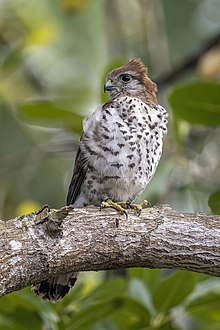
Back موريشيوس كيستريل ARZ Mavriki qızılquşu Azerbaijani Маврицийска ветрушка Bulgarian Xoriguer de l'illa de Maurici Catalan Falco punctatus CEB Cudyll coch Mauritius Welsh Mauritiustårnfalk Danish Mauritiusfalke German Maŭricia turfalko Esperanto Falco punctatus Spanish
| Mauritius kestrel | |
|---|---|

| |
| Ebony Forest, Mauritius | |
| Scientific classification | |
| Domain: | Eukaryota |
| Kingdom: | Animalia |
| Phylum: | Chordata |
| Class: | Aves |
| Order: | Falconiformes |
| Family: | Falconidae |
| Genus: | Falco |
| Species: | F. punctatus
|
| Binomial name | |
| Falco punctatus Temminck, 1821
| |

The Mauritius kestrel (Falco punctatus) is a bird of prey from the family Falconidae endemic to the forests of Mauritius, where it is restricted to the southwestern plateau's forests, cliffs, and ravines.[3] It is the most distinct of the Indian Ocean kestrels. It colonized its island home to evolve into a distinct species probably during the Gelasian (Late Pliocene[4]). It is the most distant living species among the western Indian Ocean kestrels (Groombridge et al. 2002, qv Réunion kestrel).
In 1974 the Mauritius kestrel was close to extinction, with only five or, possibly, six known birds of which two in captivity and a solitary breeding female. In 1985, numbers were estimated to have increased slightly in the wild, but it remained critically endangered at fewer than 15 individuals.[5]
After considerable pioneering conservation efforts by Carl G. Jones and Abdool Wahab Owadally the numbers had increased to circa 400 birds in 2019. This conservation achievement is regarded as one of the most successful and best documented bird restoration projects in the world.[6] It was proclaimed the national bird of Mauritius in March 2022 to mark the 30th anniversary of the Republic of Mauritius.[7]
- ^ BirdLife International (2023). "Falco punctatus". IUCN Red List of Threatened Species. 2023: e.T22696373A226885309. doi:10.2305/IUCN.UK.2023-1.RLTS.T22696373A226885309.en. Retrieved 20 May 2024.
- ^ "Appendices | CITES". cites.org. Retrieved 2022-01-14.
- ^ Ellis, Richard (2004). No Turning Back: The Life and Death of Animal Species. New York: Harper Perennial. p. 279. ISBN 0-06-055804-0.
- ^ Possibly to be moved to the Early Pleistocene. See Groombridge et al. (2002) for a thorough discussion of this species' recent evolutionary history.
- ^ THE STATUS, ECOLOGY AND CONSERVATION OF THE MAURITIUS KESTREL (PDF). 1985. p. 211.
The Mauritius Kestrel (Falco punctatus) had been studied since early 1973 and its life history is now fairly well known. It is a distinctive island form, the males averaging 130-140g and the females 160-170g. There is no readily detectable difference between adults and immatures, as all have the female type plumage. The species has evolved in the evergreen sub-tropical forests of Mauritius and occupies a niche similar to that of an accipiter. In morphology and behaviour it also shows convergence with accipiters, with short rounded wings and a dashing hunting technique. Considerable attention has been focused on this kestrel because of its extreme rarity and apparent impending extinction. In 1974 the world population was stated to be only six individuals, including two in captivity. Since then the kestrel is thought to have increased slightly in the wild, but it still remains critically endangered at fewer than 15 individuals.
- ^ "The Mauritius Kestrel: A Conservation Success Story | Wildlife Preservation Canada Blog".
- ^ "The Mauritius Kestrel officially proclaimed National Bird of the Republic".
